Seeing without Judging: Passing through the Doors of Perception


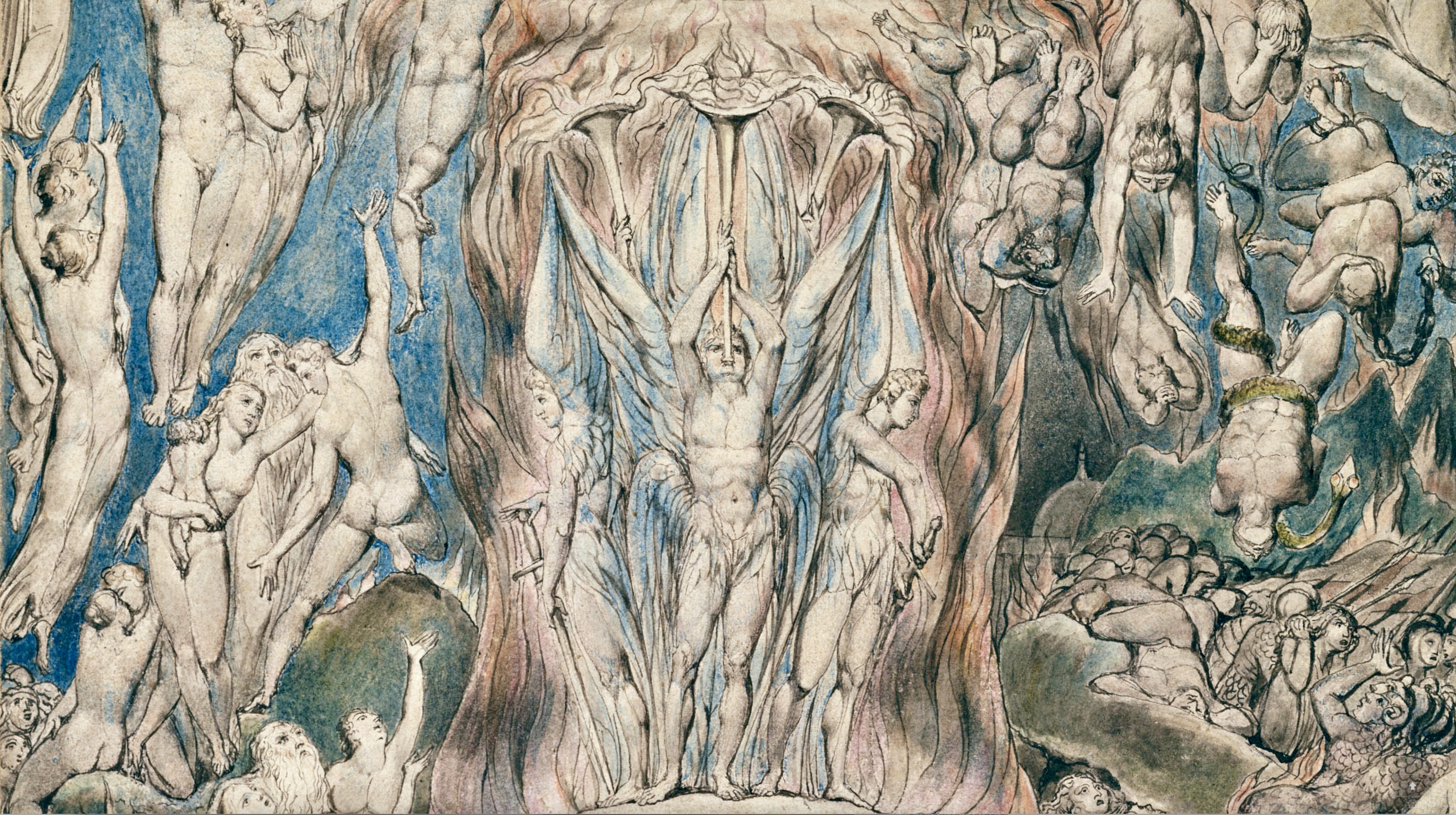
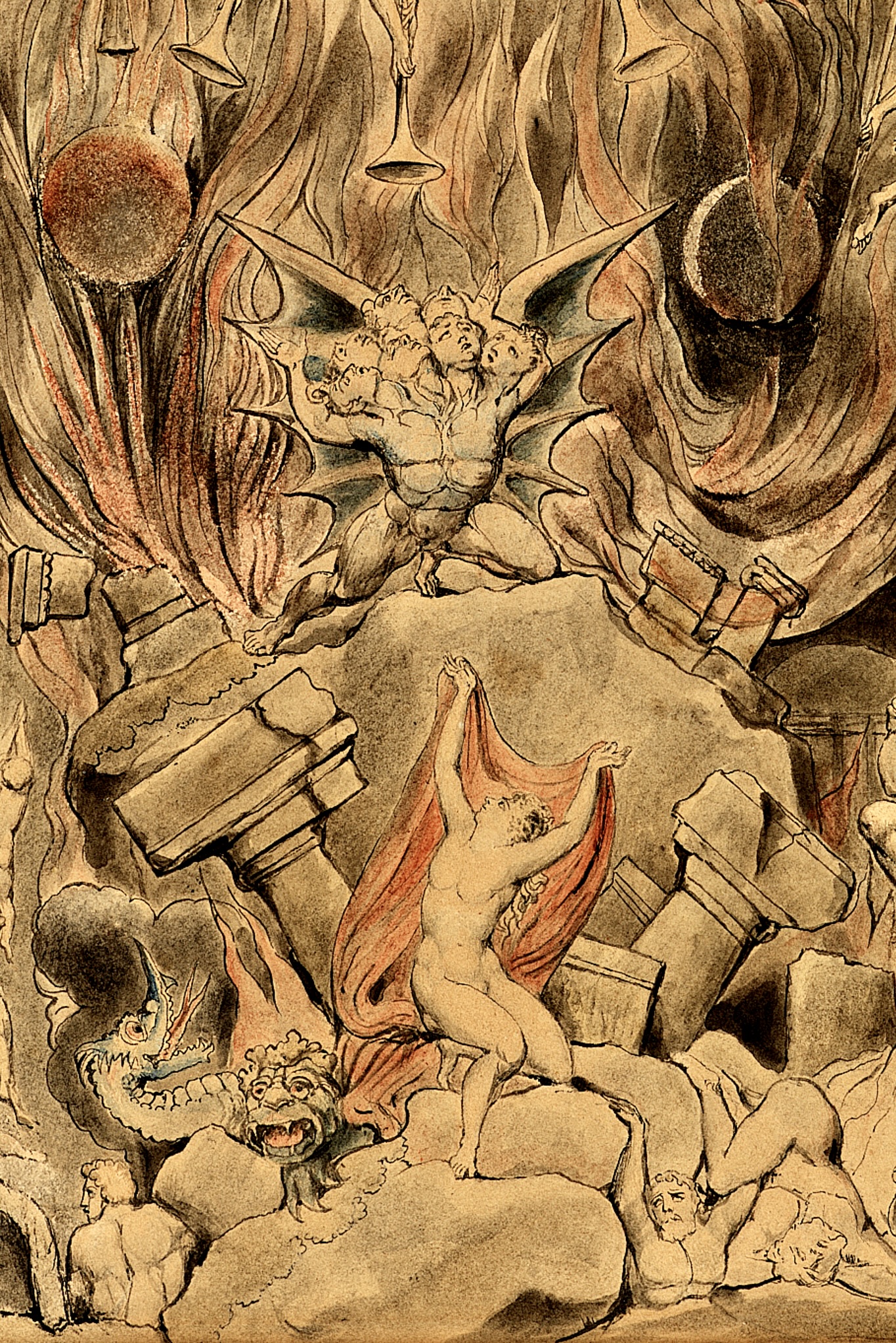
![]()
Introduction: The Last Judgment
The ancient tradition that the world will be consumed in fire at the end of six thousand years is true. as I have heard from Hell.
For the cherub with his flaming sword is hereby commanded to leave his guard at the tree of life, and when he does, the whole creation will be consumed, and appear infinite and holy whereas it now appears finite & corrupt.
This will come to pass by an improvement of sensual enjoyment.– Blake, The Marriage of Heaven and Hell
In order to see reality as “infinite and holy” Blake’s advice is to let go, to “surrender”: to cast one’s rationalising, judgmental ego or “Selfhood” into the “Lakes of Los”, and to let go of the entire egoic program. We can have no real relationship or communion with reality while we are judging it: to judge something is to stand outside it, and to convert living contraries into dead and conflicting ideas or opposites (“good and bad”, “light and dark” etc).
The Hebrew word for “judges” is “Elohim“: it’s the name given to the “God” of the Book of Genesis which presides over our expulsion from Eden, that is from the present moment – from Being. This is what Judgment does to the human form and the human brain: this is what the Judgment program looks like:
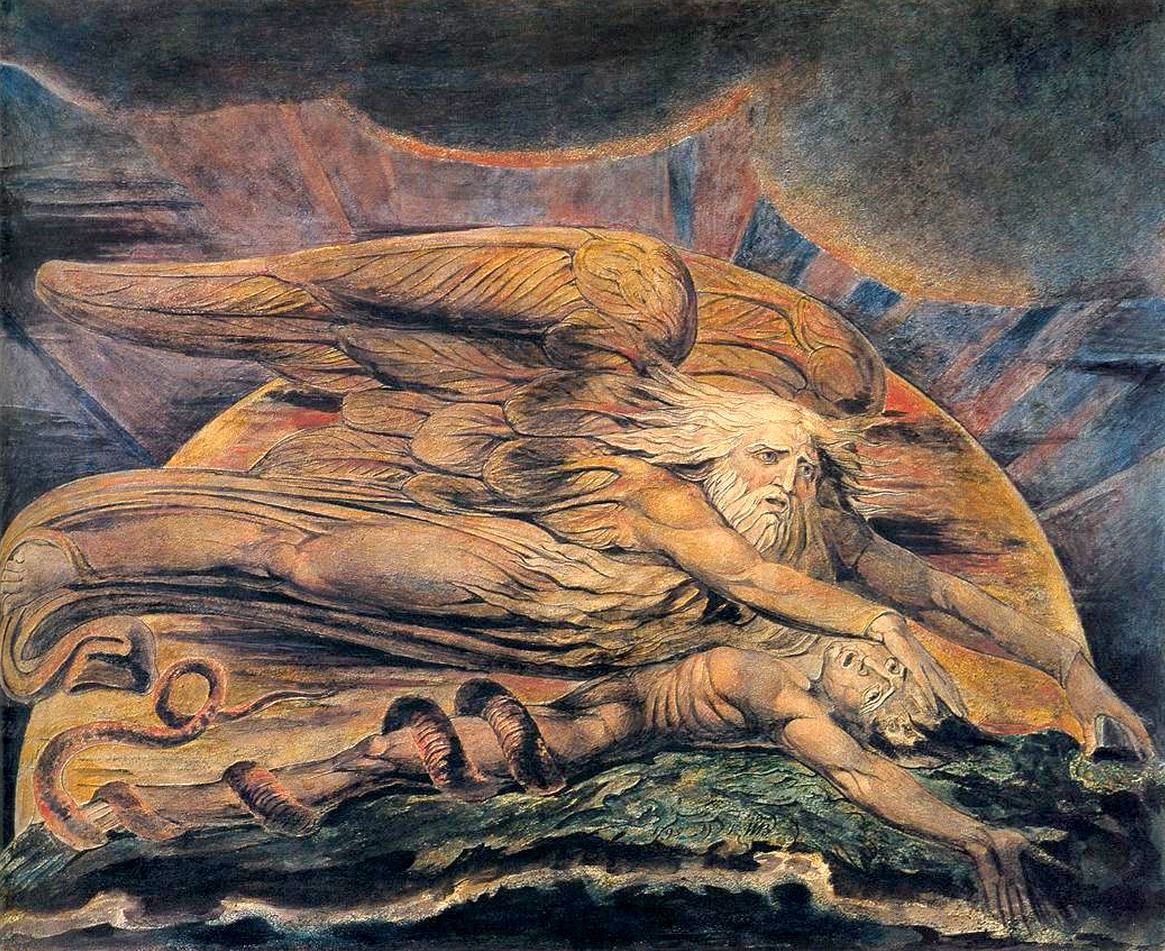
Elohim Creating Adam, by Blake (c. 1795-1805). The Biblical name for the “judge” or “judges” within the psyche of man is “Elohim”, and as such they appear in the Book of Genesis. “And God [Elohim] said, Let us [plural] make man in our image, after our likeness” (Genesis 1:26). It is no coincidence that this moment of “creation” (or rather “division”) is shortly followed by the eating of the tree of “good and evil”, and the even swifter expulsion from “Paradise” (i.e., from integrated Being) as a result. As Blake suggests in the detailed notes he made for his Vision of the Last Judgment (1810), every time a judgment is made about reality, the same “Satanic” process or judgment program (within “Adam”) gets activated.
In many ways, Blake’s whole poetic output has been leading up to this moment: the moment in his work where the individual finally realises the nature of his own psyche, and becomes aware of the pathological nature of the egoic Selfhood that had previously controlled and conditioned him.
In Jerusalem: The Emanation of the Giant Albion (1820), Blake himself directly addresses the human imagination as that agency within man which can give “Error” a form (so that it can be ‘seen’, so that it can be known and rejected), and which also operates above and beyond normal (egoic or rational) consciousness, in order to “Annihilate the Selfhood in me” (J 5:22). With the profoundly unconscious rational Selfhood no longer “God” of the human perceptual and cognitive system, of the left hemisphere of the brain, the individual can finally “awake from Slumbers of Six Thousand Years”.
Note in the picture above that the Elohim’s right hand (i.e., left hemisphere) is directly targeting Adam’s right hemisphere, as if to take control of it, to demobilise and suppress it. The right brain is non-judgmental and relational; it contains the networks and processes of empathy, inter-connectedness, “I/Thou’ relationships, intuition, betweenness, and being itself (through its intimate and extensive connection to the human body, and to embodiment). This act effectively makes the deeper intelligence and awareness of the right brain “unconscious” or as Blake says, “asleep”.

The cloven hooves of the Elohim Program: the Dividing, Judging Power within the Brain. Image: ‘Job’s Evil Dreams’ from Blake’s Illustrations of the Book of Job. Note the irony, and inversion, of the title: Job’s “Evil” dream is of a “Good” god. How can this be?
The “Creation” – that is, the conversion of the infinite and holy world into a “natural” or material world riven by discrete objects in perpetual conflict – is a moment of profound torment and agony.
Look how unconscious both agents are in this process of conversion. And yet, in another of the inversions that this process (the elevation of the Elohim over Adam, and the left hemisphere into dominance and Mastery), this deep sleep or unconsciousness is what we now call (rational) consciousness – the externalising, rationalising, atomising, “objecting” (as Blake beautifully describes it – deftly combining both its judgmental character and its conversion of the flow of bring into “object representations”, into things) nature of this “Fall into Division”.
The result, suggests Blake, has been “six thousand years” of humanity being “asleep” (this correlates with the ascendancy of these powerful judging, rationalising, and measuring programs of the brain in the cultures of Sumer, Babylon, and Egypt around 4,000 BC). But now, he notes, we are slowly beginning to realise what’s happened to us, and the false nature of the reality we find ourselves in.

The Whore of Babylon, a key figure or archetype in the process of our estrangement from Being and the processes of judgment and alienation that facilitate it, here shown sitting on the back of the Great Beast. (Image: ‘The Harlot and the Giant’ from Blake’s Illustrations to Dante’s Divine Comedy). As Blake noted in 1798, in contemporary culture and society “The Beast & the Whore rule without controls” (Annotations to Watson). We will see this figure again in Blake’s many Visions of the Last Judgment.
Blake refers to this process, which he also calls “awakening”, as a casting off or a letting go of the Selfhood. The Selfhood is what the Judging program uses to define itself and give it a sense of power (putting itself “up” by judging others and putting them “down”; the vocabulary of up and down, higher and lower, is always a sign of the presence of the Elohim). Awareness is the letting go. As Blake noted, “whenever any Individual Rejects Error & Embraces Truth a Last Judgment passes upon that Individual” (LJ 84).

The old, or orthodox, version of The Last Judgment. This version is, both ironically and appropriately, itself the expression of the Judging power that has usurped its position in the human brain. (Image: ‘The Last Judgment’, or Il Giudizio Universale, by Michelangelo in the Sistine Chapel). As Damon notes, such a view of both Judgment and of Jesus (as Judge) “was utterly opposed to Blake’s belief in the character and teaching of Jesus”. As with his admiration for both Dante and Milton, whose work Blake celebrated but whose erroneous belief systems he corrected, Michelangelo’s imaginative power was an inspiration for Blake, but not a wholly uncritical one.
This shows how radically Blake has reinterpreted and indeed cast off the traditional meaning of the “Last Judgment”. Rather than denoting something that might happen at the end of linear time, or as a punishment, Blake suggests that it happens and is happening now (it is the ending of the linear time “program”), and instead of it referring to a process of accusation and condemnation, it is a release from all programs of accusation. Indeed, the end of linear time can never arrive for the left hemisphere, since to be identified with the left brain is to be inside the linear time construct. As Damon has observed:
The Last Judgment, according to orthodox Christianity, will not occur until the end of the world; then Jesus shall return and judge all mankind, living and dead, separating the good sheep from the evil goats. The saved shall be rewarded with everlasting bliss, while the damned shall be punished with everlasting torture. Such a concept was utterly opposed to Blake’s belief in the character and teaching of Jesus. It contradicted both infinite Mercy and the Forgiveness of Sins.
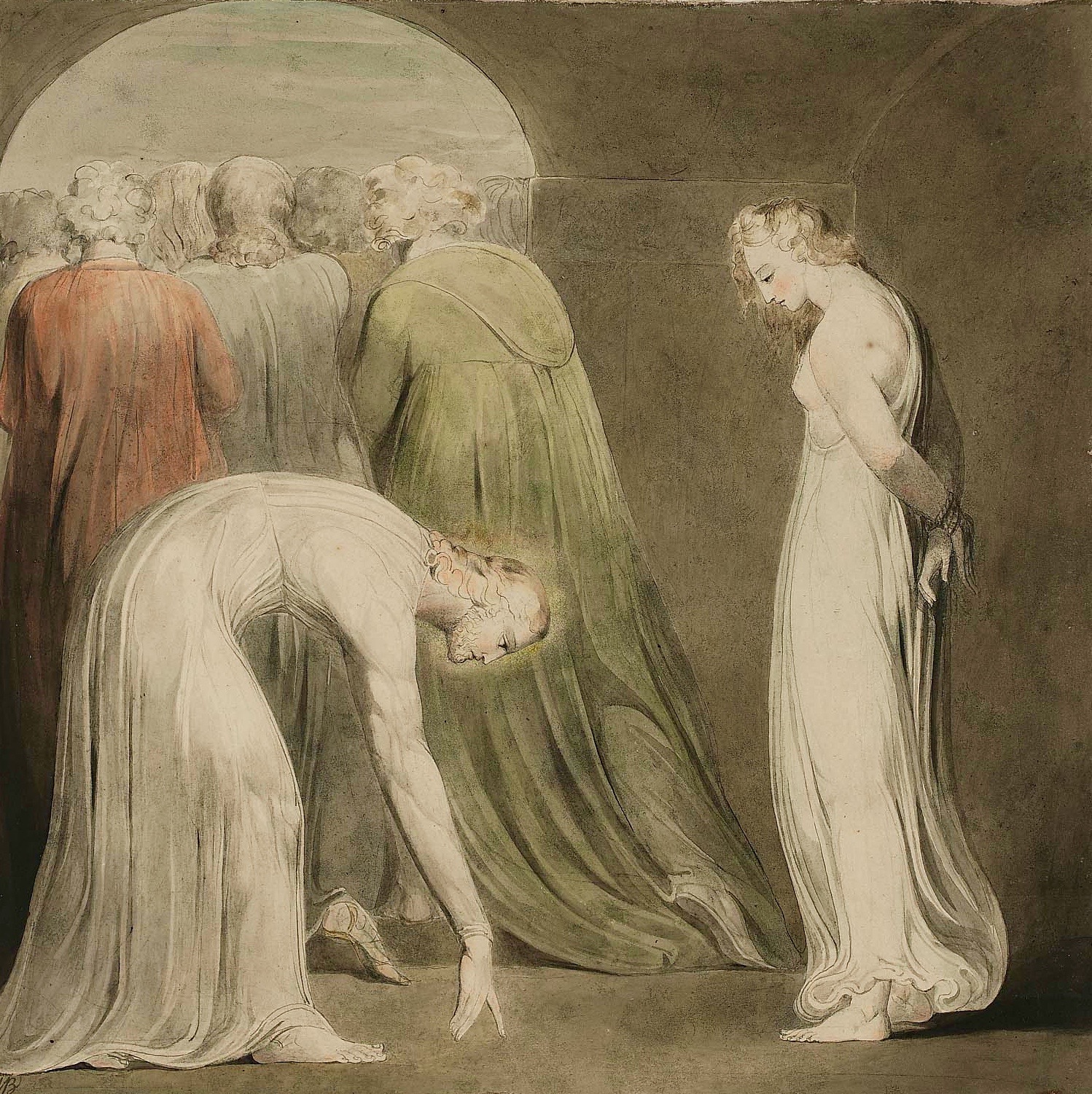
The Woman Taken in Adultery, by Blake (c. 1805). Jesus is invited to judge the woman; instead he forgives her and challenges the entire system of judgment and objectification (of turning a “Thou” into an “It”, as Buber notes) upon which the contemporary legal and religious system – then as now – was built. Jesus might be seen as in a sense hacking into the source code of his culture and rewriting its html in order to upgrade and update its underlying codes. ‘Ye have heard that it hath been said, An eye for an eye, and a tooth for a tooth’, Jesus for example remarks. ‘But I say unto you, That ye resist not evil: but whosoever shall smite thee on thy right cheek, turn to him the other also.’ His whole series of ‘logia’ or teachings are built around this formula (‘Ye have heard that … But I say unto you,’), a radical re-formulating and re-framing of moral norms and orthodoxies. Forgiveness liberates us and restores us to the relational field. Judgment separates us and estranges us from being.
Damon adds that Blake may have developed his idea from a suggestion in Swedenborg, who also locates the process as occurring in imaginative reality rather than in the rational brain’s abstract and linear concept of “future”. This concept of “Judgment” was itself an “Error”. Thus, Damon adds, according to Blake “a Last Judgment occurs whenever an error is recognized and cast out. It may occur at any time for the individual (as with Job, Illustr Job 16), and it also occurs on a world-wide basis at great moments of historical upheavals”.
Both Blake and Tolle point to this “world-wide” aspect of the process, suggesting that this awareness has a broader social character, as well as a personally transformative one. Indeed, this broader character is very much the point of the awareness. It is a breaking down of separation, of inner and outer.

Judging isolates both us and them. We found this out in the garden. Judging promises us great powers: “then your eyes shall be opened, and ye shall be as gods, knowing good and evil.” But in fact true divinity is not interested in questions of “good and evil”, as Blake continually reminds us. “In Hell all is Self Righteousness there is no such thing there as Forgiveness of Sin he who does Forgive Sin is Crucified as an Abettor of Criminals. & he who performs Works of Mercy in Any shape whatever is punishd & if possible destroyd” (VLJ).
A similar process occurs with regards to judging. As Tolle observes, judging is one of the most fundamental processes of the egoic rational mind, one of its deepest programs. “Making yourself right and others wrong is one of the principal egoic mind patterns, one of the main forms of unconsciousness” (Tolle, 2005). Such judgments strengthen the ego “by giving it a feeling of superiority on which it thrives”. To cease to judge is immediately to liberate the mind, but the processes of judging have become so engrained and entwined within the human brain that this is neither a straightforward nor an easy act. Tolle notes that “if you stop investing it with ‘selfness,’ the mind loses its compulsive quality, which basically is the compulsion to judge, and so to resist what is, which creates conflict, drama, and new pain. In fact, the moment that judgment stops through acceptance of what is, you are free of the mind” (Tolle, 1999).
![]()
A Vision of the Last Judgment: The Rejection of Judging and the Embrace of Forgiving

‘A Vision of the Last Judgment’ (pen and watercolour, 1806). This is the earliest of the surviving versions of the scene by Blake – or rather the versions of the moment or process within the human brain and body of the last ‘judgment’, which is also the ending of Time (that is, the cessation of the time program within the linear, rationalising mind).
The “moment that judgment stops” is exactly what Blake means by “Last Judgment”. In 1808 he completed A Vision of the Last Judgment, a large fresco depicting this inner process of liberation. The painting was intended to be shown in an 1810 exhibition, accompanied by a detailed analysis of the work which he added to the second edition of his Descriptive Catalogue. This plan was dropped after the exhibition was cancelled, and the painting has since disappeared. Fortunately Blake’s extraordinary descriptive notes to the work have survived, together with earlier versions of a similar scene, such as the watercolours that he made for Thomas Butts in 1806, 1807, and 1809, one for John Flaxman in 1806 (also now lost), and an 1809 unsold version in tempera. It was clearly a theme that preoccupied him during these years.
The scene depicted is not quite that which at first appears to the rational eye: an apparent celebration of judgment and prospective eschatological reward and punishment. Instead, Blake’s painting portrays the annihilation of judgment, the process of casting out Urizenic or left-hemispheric dominance. “I do not consider either the Just or the Wicked,” Blake notes, “to be in a Supreme State but to be every one of them States of the Sleep which the Soul may fall into in its Deadly Dreams of Good & Evil” (VLJ 92).
Such is the Last Judgment a Deliverance from Satans Accusation Satan thinks that Sin is displeasing to God he ought to know that Nothing is displeasing to God but Unbelief & Eating of the Tree of Knowledge of Good & Evil [VLJ 90]
If this assault on the dysfunctional nature of intellectual and moral “judgment” was not clear enough, he adds that regaining “Paradise” precisely consists in no longer running these isolating and self-hardening programs, “no longer talking of what is Good & Evil or of what is Right or Wrong” (VLJ 90). This was the reason why we left it.
What constitutes this Edenic mental State is not choosing “Good” over “Evil” (obedience over energy) but in rejecting the judgmental program that defines reality in these terms in the first place. What replaces this insistent and incessant (compulsive) judging of reality is acceptance and forgiveness. As Blake puts it, Eden is constructed out of “Mutual Forgiveness”: not putting other people “down” or accusing them. The fastest way out of Eden is to think that you’re better than someone else (i.e., than humanity). More mundanely, simply moaning about the weather will do it (that is, criticising the nature of being, of Now), a popular option if you live in England.

‘The Last Judgment’ (pen and watercolour, 1808). Note how the image is also like a body, and how organic – even visceral – the organs and circulations within it are. Blake often talked about “the Human Form Divine”, and of the divinity of embodiment, and of the importance of the “Minute Particulars” – suggesting that the infinite is contained within, or enfolded within, the finite. Bodies are not illusory forms or representations (which is how the left brain sees them), they are living portals into eternity, generated by the underlying implicate order which is better thought of as the Divine Imagination, the generator and regenerator of all images and forms (that is, of being), and therefore what Blake calls “the True Vine of Eternity”: “All Things are comprehended in their Eternal Forms in the divine body of the Saviour, the True Vine of Eternity, The Human Imagination” (VLJ).
![]()
The Left or the Right: The Eschatological Asymmetry of Redemption
As with traditional representations of the Last Judgment, Blake visually portrays this process as an event occurring between the left and the right, although again he radically reinterprets the meaning of these terms. Being holy, obedient, moral, and pure were usually considered (in the Urizenic universe governed by the God of Reason) as qualities that got you into heaven, and upon which the soul was judged accordingly. This rationalistic assumption goes back at least as far as ancient Egypt, and the “weighing” of the soul after death. In subsequent Christian art the “righteous” were depicted on the “right” of the Logos (Christos), awaiting their “ascension” into the “up” world of left-hemispheric heaven.
As McGilchrist notes, “It is perhaps significant that the functions the conscious left hemisphere associates with itself – optimism, control, consciousness, rationality – are all expressed by means of the spatial metaphor ‘up’ … Examples are (optimism) being upbeat, lifting one’s spirits; (control) having control over, ranking above; (consciousness) waking up, but falling asleep; (rationality) rising above one’s feelings, but breaking down in tears” (The Master and his Emissary).
And as I suggest in The God of the Left Hemisphere, the narrative of hemispheric struggle (which is only a struggle form the left hemisphere’s point of view) “also seems to be contained in ancient stories concerning the battle between intelligent ‘Sky Gods’ on the one hand (such as Zeus, Jupiter, Jehovah, and Odin), and the Titans or Giants on the other”. Up and Down again: the elevated “sky” gods of the new hemispheric pantheon (powerful, cunning, and associated with solar consciousness), and the casting down of the previous chthonic giants and deities of the preceding hemispheric era. The sky and the stars constitute the domain that the abstracting, self-elevating, hierarchical left brain spontaneously gravitates towards, and regards as it’s “home”.
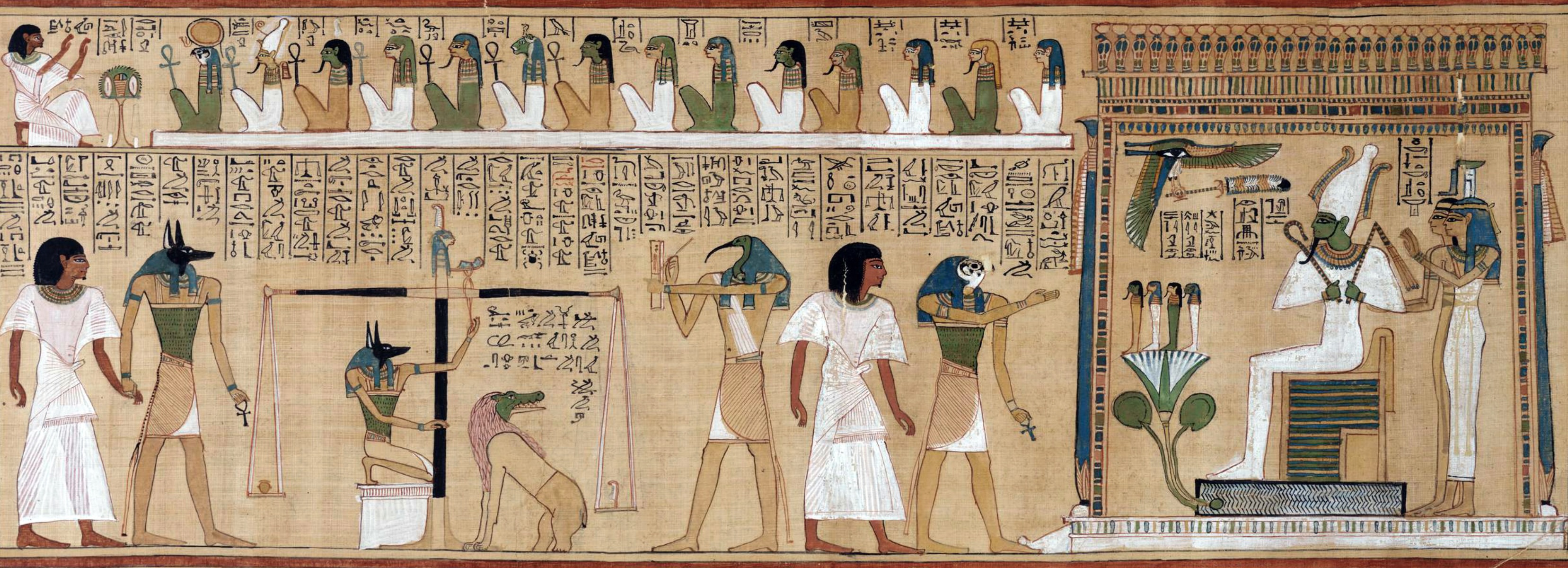
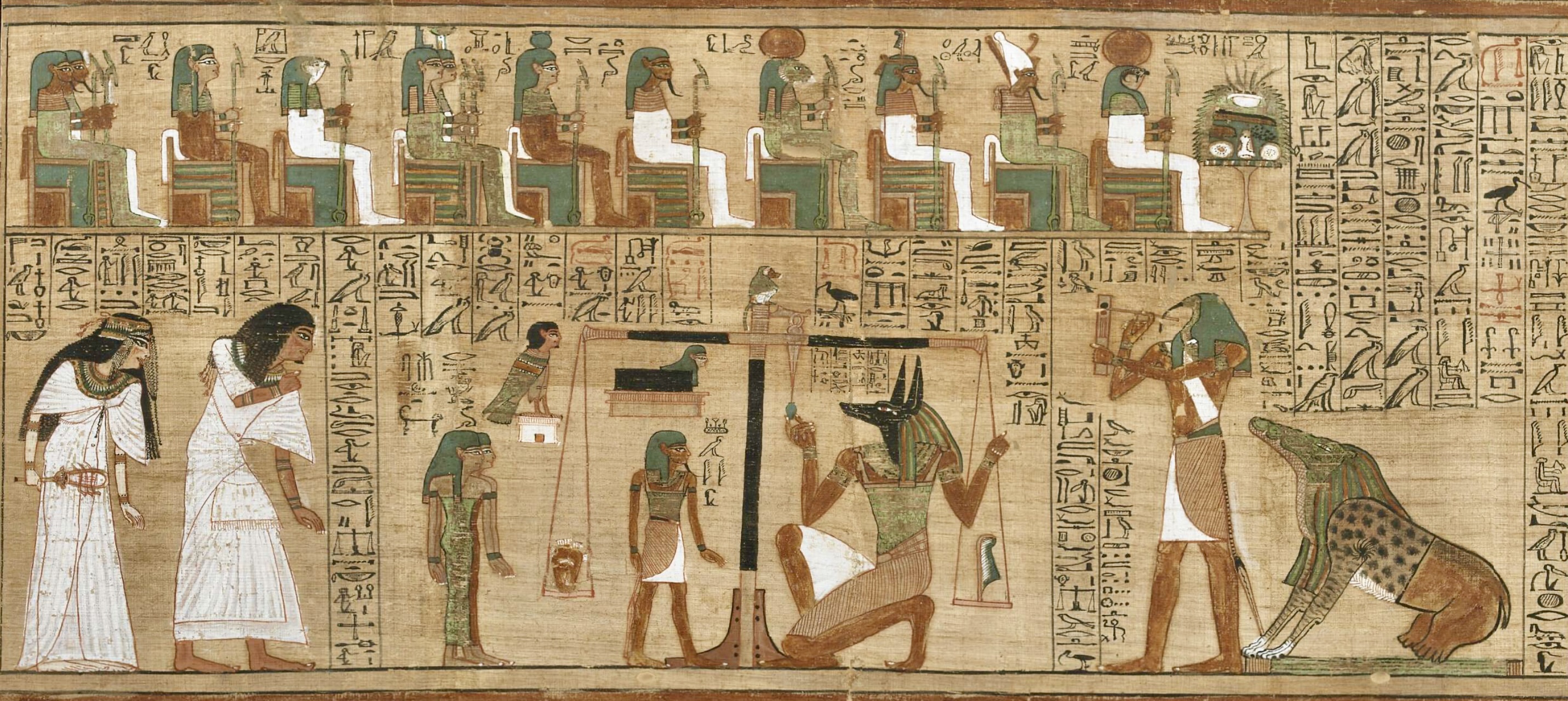
Above: page from the Book of the Dead of Ani (c. 1275BC, Egypt). The scene reads from left to right. To the left, Anubis brings Hunefer into the judgement area. Anubis is also shown supervizing the judgement scales. Hunefer’s heart, represented as a pot, is being weighed against a feather, the symbol of Maat, the established order of things, in this context meaning ‘what is right’. The ancient Egyptians believed that the heart was the seat of the emotions, the intellect, and the character, and thus represented the good or bad aspects of a person’s life. If the heart did not balance with the feather, then the dead person was condemned to non-existence, and consumption by the ferocious “devourer,” the strange beast shown here which is part-crocodile, part-lion, and part-hippopotamus. Below: ‘Book of the Dead’, Papyrus of Ani (c. 1250BC, Egypt). The scene is again the Hall of Judgment. Centrally placed is a balance, holding in its two pans Ani’s heart (on the left) and a feather (on the right) representing Maat, the divine personification of truth and order. Note in these two images the similarities, as well as differences, with later Christian scenes of “judgment” and with Blake’s unique take on them. For example: the notions of left and right in both (though linear, as in alphabetic script, in the Egyptian, and lateral, as in the human body, in Blake); the central seated figure of a scribe, writing (Thoth, the left brain interpreter, in the Egyptian; Jesus, the internal imagination, in Blake); the static feel of the Egyptian representations, and its emphasis on measurement, balance, weighing, and order, versus the extraordinarily dynamic and flowing movement of Blake’s, with its emphasis on celebration, joy, circulation, and self-awakening.
However, Blake suggests that it is precisely the “righteous” or self-righteous qualities (judgmentalism, superiority, anti-body purity etc) that psychologically bar you from entering the kingdom, the Now. “Men are admitted into Heaven not because they have <curbed &> Governd their Passions or have No Passions but because they have Cultivated their Understandings. The Treasures of Heaven are not Negations of Passion but Realities of Intellect from which All the Passions Emanate <Uncurbed> in their Eternal Glory” (VLJ 87).
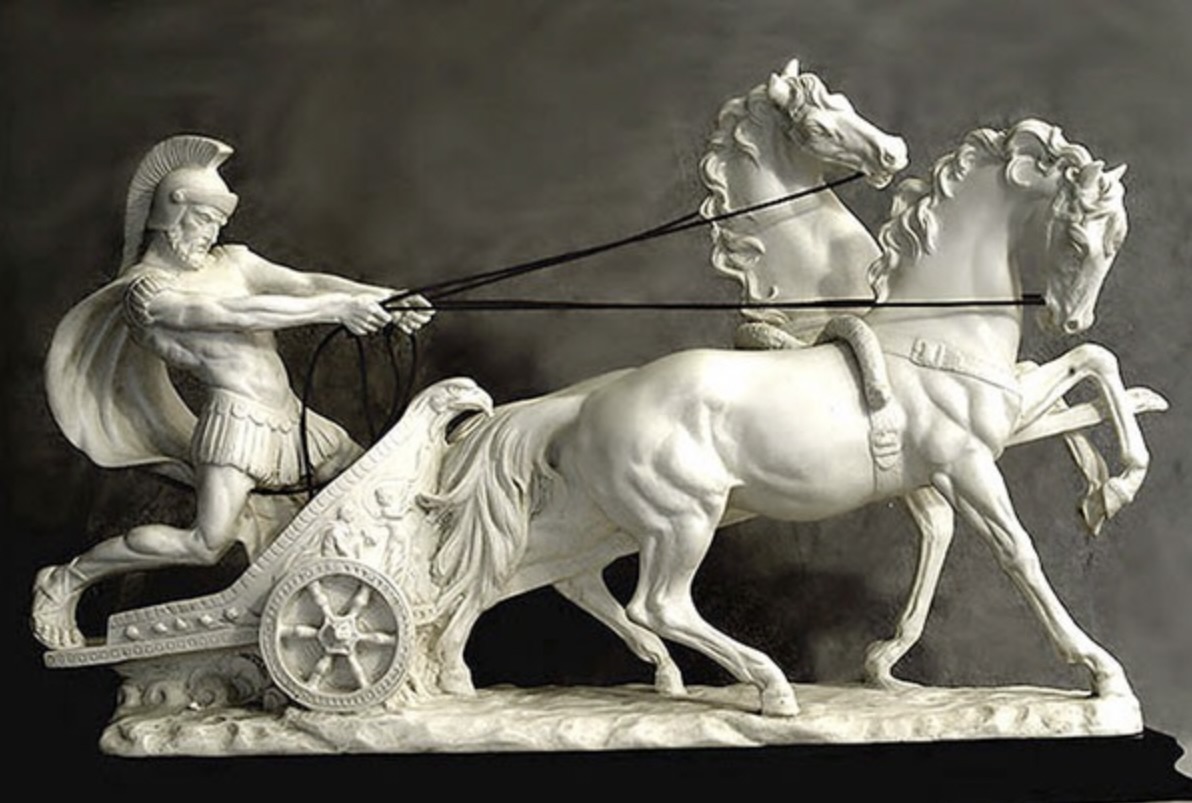
The rational soul’s very self-flattering view of itself, as a heroic, civilised commander in charge of wayward, primitive, seething animal passions. “For Plato and other rationalists (including Freud), ‘Passion’ was a chaotic and obstinate horse that had to be whipped, bridled, and negated as far as possible (‘purified’).” Thus in relation to the “id” Freud argued that the ego “is like a man on horseback, who has to hold in check the superior strength of the horse” (Freud, 1923b). Plato’s counsel is similarly for the rational charioteer to violently dominate the poor horse: “… and with a still more violent wrench [he] drags the bit out of the teeth of the wild steed and covers his abusive tongue and jaws with blood, and forces his legs and haunches to the ground and punishes him sorely. And when this has happened several times and the villain has ceased from his wanton way, he is tamed and humbled, and follows the will of the charioteer”. This is presumably how Plato regarded his own id. It is also a fairly accurate description of the contemporary education system. We now know however that the relationship is almost entirely reversed: it is the (right hemisphere) “id” that is actually conscious and indeed far more aware than the poor rational, slow, cognitive “ego” (see Solms & Panksepp, The Conscious Id, 2017), which is relatively “unconscious”. A more realistic view of the Rational Charioteer might be of the tiny rat in the film Ratatouille, sitting on top of the chef’s head and thinking it controls everything.
Whereas for Plato and other rationalists (including Freud), “Passion” was a chaotic and obstinate horse that had to be whipped, bridled, and negated as far as possible (“purified”, and made “conscious”), in the integrated individual the Passions are the divine emanations of Being itself.
A “Last Judgment’ is necessary, Blake observes, not only to stop the continual moralising in the head that shuts off heaven, but to stop the moralisers and the moralising programs from hindering and obstructing the true nature of imaginative existence, which is delivered through the right hemisphere.
Holiness is not The Price of Entrance into Heaven Those who are cast out Are All Those who having no Passions of their own because No Intellect. Have spent their lives in Curbing & Governing other Peoples by the Various arts of Poverty & Cruelty of all kinds Wo Wo Wo to you Hypocrites [VLJ 87]
It is to prevent this “Curbing & Governing” of the imaginative, forgiving faculty that the Last Judgment comes within the brain of Man. As Blake notes, “A Last Judgment is not for the purpose of making Bad Men better but for the Purpose of hindering them from oppressing the Good with Poverty & Pain by means of Such Vile Arguments & Insinuations” (VLJ 85).

“All the current systems of egoic rational control of the humane and imaginative basis of the individual are therefore shown by Blake as being cast out, swept out of the psyche of man and depicted as falling headlong (i.e., driven by their rational heads) into the depths.”
As McGilchrist has suggested, the evolutionary strategy pursued by the left hemisphere has indeed been based precisely on the hindering or “handicapping” of right-brain processes: “left hemisphere superiority is based, not on a leap forward by the left hemisphere, but on a ‘deliberate’ handicapping of the right” (M&E). All the current systems of egoic rational control of the humane and imaginative basis of the individual are therefore shown by Blake as being cast out, swept out of the psyche of man and depicted as falling headlong (i.e., driven by their rational heads) into the depths.
On the “left” (unconscious) side of his painting are therefore shown those who “plead their own Righteousness”, those who compulsively pursue “the vanities of Riches & Worldly Honours”, such as priests, religious dignitaries, the Pharisees, the proud, the treasurers (Shebna), “Babylon represented by a King crowned”, the stones of the Mosaic law tossed out into the abyss, together with assorted “Kings & Councellors & Warriors”, the Cross, the papal tiara, and the royal crowns, indeed all the assorted jetsam and waste products of humanity.
The figures falling into the abyss are those who were momentarily powerful and famous, yet who actually produced no good or lasting benefit to humanity while they were alive precisely because they were so consumed with their own needs and status (VLJ 77–80). In the end it is this egoic consumption which consumes them.

“Those who ‘plead their own Righteousness’, those who compulsively pursue ‘the vanities of Riches & Worldly Honours’, such as priests, religious dignitaries, the Pharisees, the proud, the treasurers (Shebna), ‘Babylon represented by a King crowned’, the stones of the Mosaic law tossed out into the abyss, together with assorted ‘Kings & Councellors & Warriors’, the Cross, the papal tiara, and the royal crowns, indeed all the assorted jetsam and waste of humanity”. We live in a profoundly inverted world: Blake’s image shows the true hierarchy and position of the (self-) damned – our current religious and political “leaders”. Babylon is depicted at the centre of this process.
![]()
The Ending of Time: The Left Brain Linear Sequencing Mode

“The ruthless, egoic, moralising processes really do have effects on the nature of individual consciousness, and they really do hinder both imaginative production and humane social existence”. In Hell all is Self Righteousness: true divinity lies with forgiveness, relationship, and Surrender to other, not in judging other. The damage that codes of Commandments, Punishments, Condemnations and “Morality” have done has been incalculable. This is the religion of the “Spectre”, as Blake terms it. “Awake, Albion awake! reclaim thy Reasoning Spectre. Subdue him to the Divine Mercy. Cast him down into the Lake of Los that ever burneth with fire ever & ever, Amen! Let the Four Zoas awake from Slumbers of Six Thousand Years” (Milton, 39:10). As Damon clarifies, “the Hell depicted by Blake in his paintings of the Last Judgment is the Lake of Fire into which Errors (but not Individuals) are cast and annihilated. ‘It ought to be understood that the Persons … are not here meant, but the States Signified by those Names’ (LJ).”
A “Last Judgment” in this sense signals the casting off or rejection of the “Temporal”, the enchainment to the linear and sequential mode of perception that alienates the left hemisphere from existence, and the heralding of its replacement by real, imaginative vision: “throwing off the Temporal that the Eternal might be Establishd” (VLJ 70).
Rather like Michelangelo’s presentation of this process of judgment as being essentially an internal or psychological one in which humans are effectively “damned” or liberated by their own minds, by the values and compulsions by which they live, so too Blake regards his “Vision” of the Last Judgment as depicting something that eternally exists: the ruthless, egoic, moralising processes really do have effects on the nature of individual consciousness, and they really do hinder both imaginative production and humane social existence, no matter how “pragmatic” or “reasonable” the confabulations and justifications of their proponents.
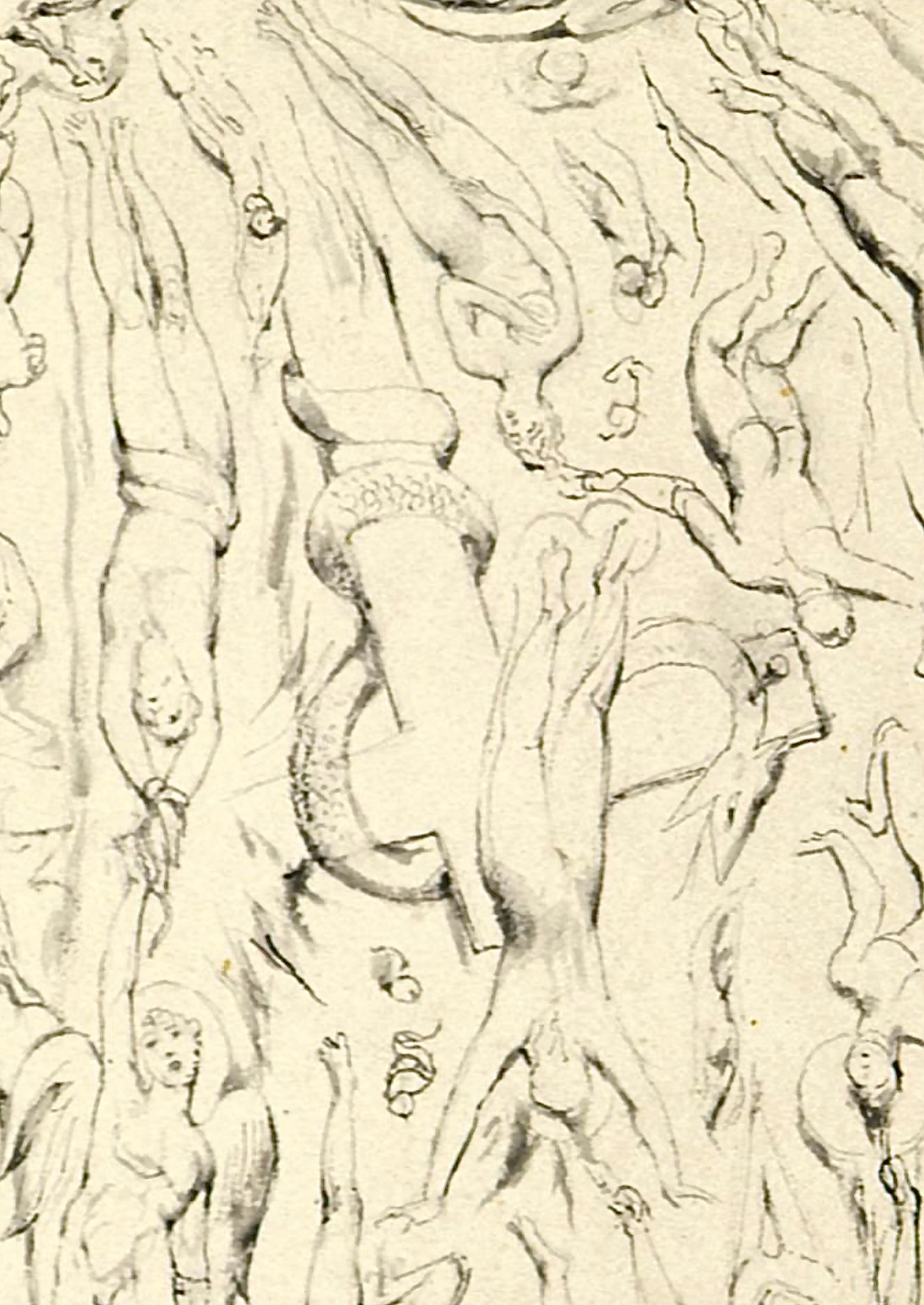
“Like the portrait of Dorian Gray, the Last Judgment is a vision of the inescapable effects of the processes of one’s choices on the inner, eternal mind of the individual.” (Image: detail from The Last Judgment, preliminary drawing, c. 1809).
Like the portrait of Dorian Gray, the Last Judgment is a vision of the inescapable effects of the processes of one’s choices on the inner, eternal mind of the individual. Since imagination is humanity itself, those who murder and condemn humanity murder and condemn their own life. “Vice” in this sense is simply the ability to drag yourself or others down: it is based on the “hindering” or handicapping of others. And it manifests itself in both the most major and appalling acts, and the most mundane and inhibitive. Thus, Blake notes, “Murder is Hindering Another Theft is Hindering Another Backbiting. Undermining C[i]rcumventing & whatever is Negative is Vice” (On Swedenborg).
Vice is “bad” not because it disobeys some commandment or breaks some social law, but because it limits and depresses perception and being, often profoundly so. This again suggests the radical shift that has occurred and is occurring within Blake’s new “integrated” vision: every human act or process is now being defined not in relation to the dissociated left hemisphere (Urizen), but in relation to the creative and expansive properties of the human imagination.
Thus, “Backbiting” and “Undermining” need to be cast out because they deaden and destroy the empathic and imaginative nature of both the person undermined and the person who undermines. Just think then what the psychological processes of contemporary politics and economics and the prevailing “logic” of the criminal justice system do to the human spirit. “In Hell all is Self Righteousness there is no such thing there as Forgiveness of Sin he who does Forgive Sin is Crucified as an Abettor of Criminals. & he who performs Works of Mercy in Any shape whatever is punishd & if possible destroyd” (VLJ 93).
As Blake suggests, no existing legal institution could continue one day if this truth was recognised and acted upon. Forgiveness is generally despised by the rational (left hemisphere) because it gives the egoic Selfhood no basis upon which to pretend to be special or superior. Forgiveness does not mean not noticing, but simply being more aware:
To relinquish judgment does not mean that you do not recognize dysfunction and unconsciousness when you see it. It means ‘being the knowing’ rather than ‘being the reaction’ and the judge. You will then either be totally free of reaction or you may react and still be the knowing … Being the knowing creates a clear space of loving presence that allows all things and all people to be as they are. No greater catalyst for transformation exists. (Tolle, The Power of Now)
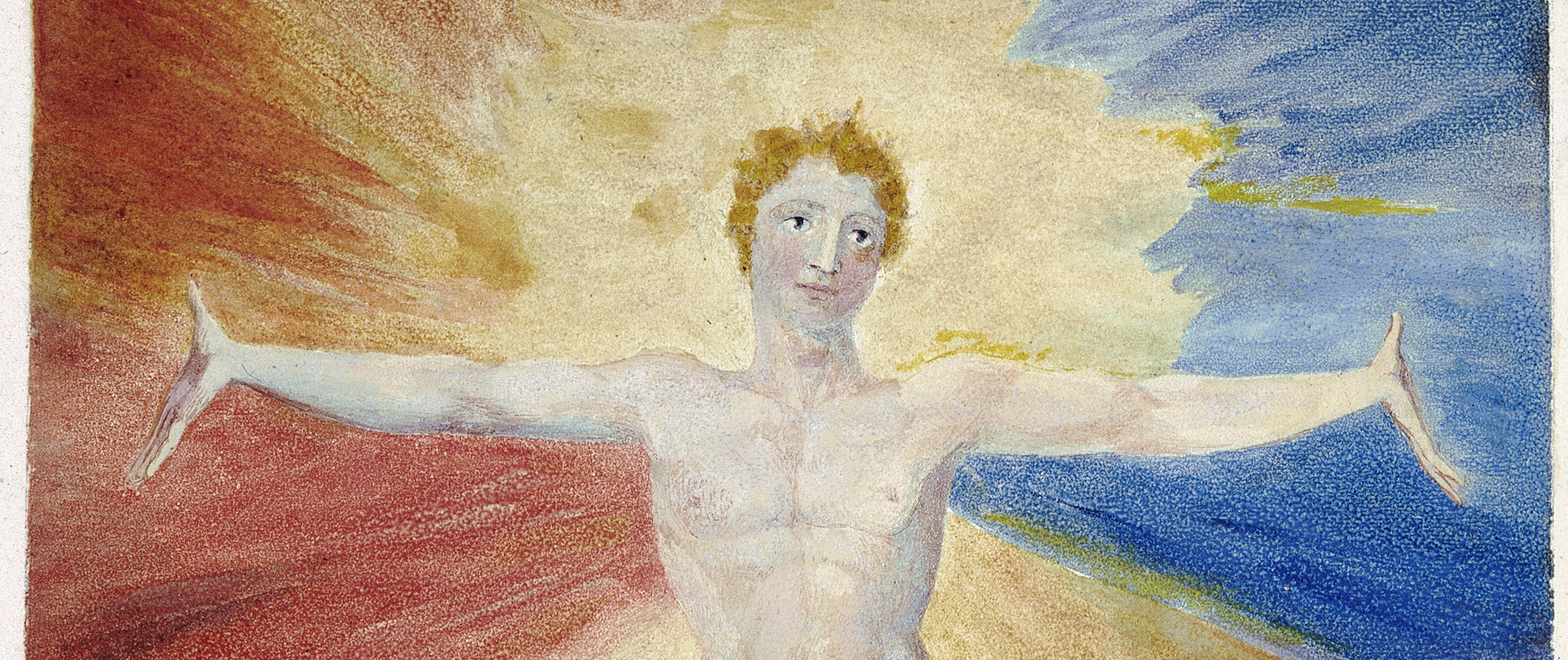
Openness, surrender, joy, embodiment, dance, relationship, expansion: these are the true ‘heaven’, if we can only get beyond the constricting, moralising, judging, analytic programs of the Urizenic fake mind.
![]()
The Elohim Program
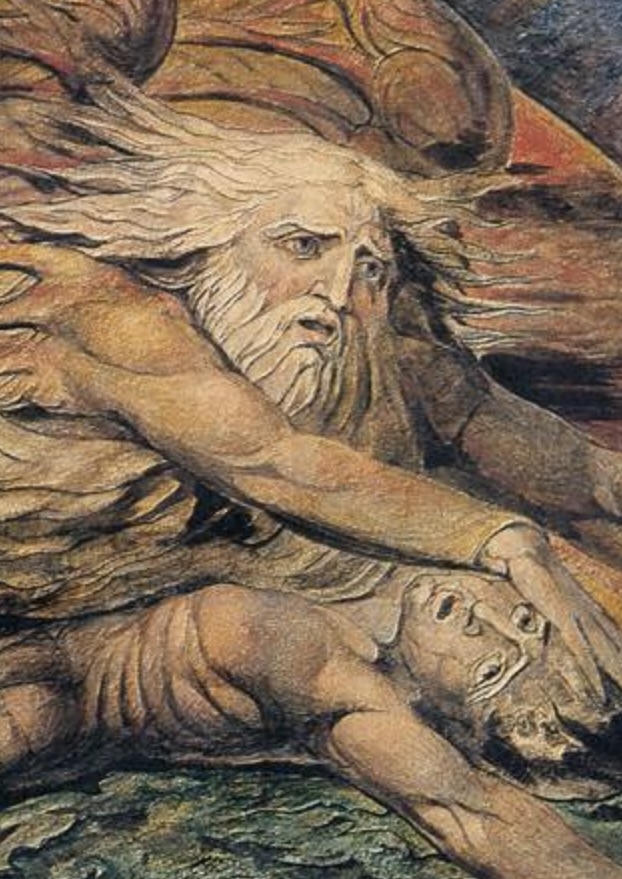
The insertion, or activation, of the Elohim Program
It is in this sense that Blake understands the processes depicted in the Bible: as profound insights and depictions of the inner psychological patterns and powers within each human individual, and within humanity considered whole. Damon has provided a useful summary of the Biblical term “Elohim” in this light, and how it appears within Blake’s work:
Elohim (“judges”) is the name of God generally used from Adam through to Noah to Abraham (as in Gen xxxiii.20); it was followed by El Shaddai, used from Abraham to Moses (in Gen xxxvii, it is translated “God Almighty”); and finally by Jehovah (Yahveh), revealed to Moses at Horeb (Exod iii.14). Elohim (an honorific plural) is the Creator in Genesis I … Sometimes the word should have been translated simply “judges,” as in Psalm lxxii.1 … Blake would have embraced this reading, as it would clarify the nature of the primal sin: that of dividing all human realities into good and evil, thus setting oneself up as judge—an error corrected by the “Judge not” of Jesus (Matt vii.1).
The Bible comes alive in this reading, as a far richer and more profound text than the rather literalist and simplistic interpretations that are often provided. Orthodox accounts not only project the “Elohim” outwards into open space, as an independently existing “object”, just like all its other supposedly independently existing objects of thought, but have mistaken this powerful psychological power or process within the brain for the “God” of the created universe, rather than as denoting the “God” or architect of the “Created” universe: the universe of finite, discrete, atom-like existences, all of which can be numbered and judged.
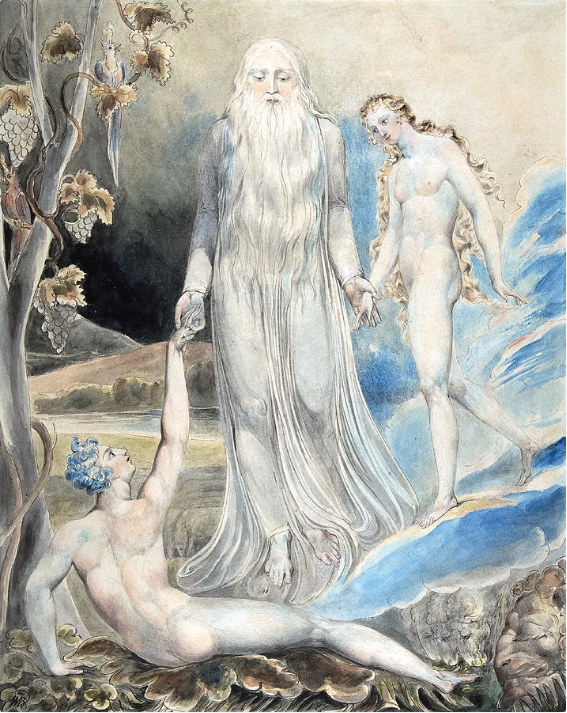
Angel of the Divine Presence Bringing Eve to Adam (The Creation of Eve: ‘And She Shall be Called Woman’), c. 1803. Note how cold the scene – this new world – is. This is what judgment and rationalisation does to the world: it’s a purified, holy, abstract version of “god” or reality – the sacred made in the image of the left hemisphere, the Emissary, the program shown here either bringing Eve to Adam, or separating Eve (the affective and limbic, relational, systems of humanity) from Adam, so that what he desires appears external to him.
The resulting fictional left-brain world is mistakenly considered to signify “reality”. Blake believed that this rationalising “God” has been repeatedly mistaken for the real divinity acting within the universe: “That Angel of the Divine Presence mentiond in Exodus XIVc 19v & in other Places this Angel is frequently calld by the Name of Jehovah Elohim The I am of the Oaks of Albion” (VLJ 81). Here again, in his notes to A Vision of the Last Judgment, Blake identifies the judging program or power of the human brain with the Druidic “Elohim”, and contrasts this “Aged Figure” with the actual divinity, the “Divine Presence”.
The Elohim denotes the judging program within each human brain: indeed, one might call this “the Elohim program”. Modern media not only caters to this program but actively drives it, through its mass distribution and regurgitation of moralising stories and newspaper headlines which invite the reader to condemn other human beings: The Daily Elohim.
The “Last Judgment” is when you cease judging reality: when the left hemisphere no longer inhibits or controls the right hemisphere, but is guided by it — which is what Blake’s scene also depicts. This is the moment when the “Curbing & Governing” processes of the dissociated rational mind stop interfering with the imaginative and forgiving faculties within Man: Blake’s painting portrays the disintegration of the Urizenic patterns and processes and the awakening or “rising” of the imaginative.

The Daily Elohim in full force: the judges judging the judges.
![]()
Details of Judgment: The topography of Blake’s psyche
One of Blake’s most famous, and complete, versions or visions of the Last Judgment is A Vision of the Last Judgement, which he composed in 1808 (using pencil, pen, and watercolour) and is now in Petworth House, Sussex (not far from where he once lived with Catherine, in Felpham). This watercolour is an earlier version of a monumental Vision of the Last Judgement that Blake painted in tempera and gold but that disappeared shortly after his death in 1827.
As Judith Wolfe notes in her excellent commentary of the picture, “the composition teems with the energy of a hundred figures, whose movements upwards (to the enthroned Christ’s right) and downwards (to Christ’s left) creates the impression of a single living shape: a human skull. It is within this human skull that Blake imagines the Last Judgement to take place: not as the final act of history, directed by an external authority, but as an apocalyptic transformation of the mind. ‘If the Spectator could Enter into these Images in his Imagination approaching them on the Fiery Chariot of his Contemplative Thought … then would he arise from his Grave'” (Exhibition: The Last Judgment).
This idea of images or forms as chariots, is key to both understanding, and entering, this work. The thing to do is not to passively observe the image, but to actively encounter it. To see not with the image but through it. All living forms are portals, and this one is no exception.
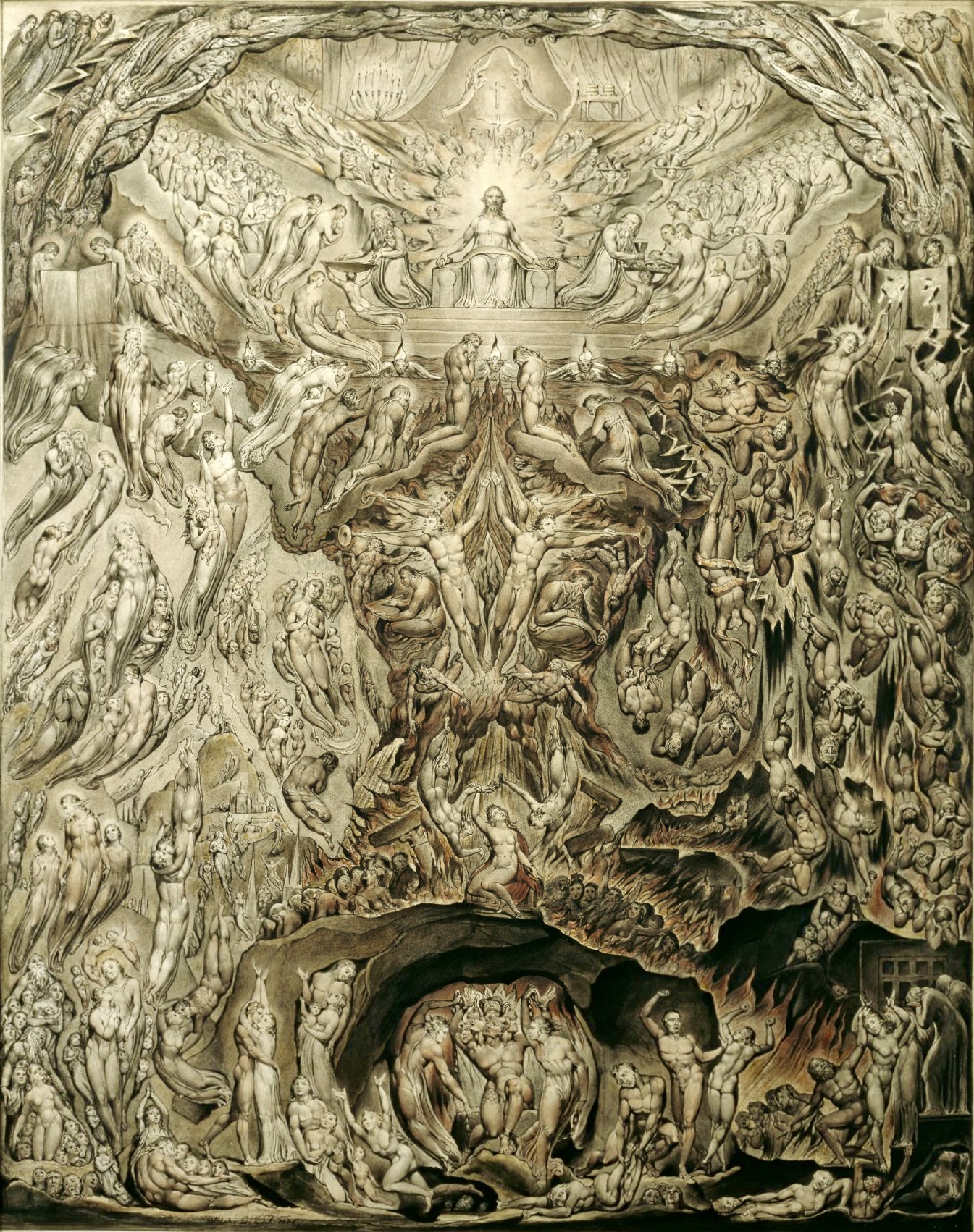
You can zoom into the image here.
“The scene is not, like more traditional Last Judgements, intended as an image of what the world will, on the last day, turn out truly to be. Rather, it is intended to represent, and therefore to liberate, the creative energy of the imagination. The very fantasticalness of the iconography of the Last Judgement, which in more orthodox depictions is a potential embarrassment to faith, is here its lifeblood. The Last Judgement, in Blake’s hands, does not fix the shape and meaning of things for all eternity, but on the contrary keeps them in an eternal dance. For the reader of Revelation, this artistic approach may jar with the text, which has a great decisiveness; but in setting our minds on fire with possibilities beyond those readily apparent around us, the painting also feeds into the work of that text by waking a desire for the overflowing joy promised in the chapter following it” (Commentary by Judith Wolfe).
As one Blake scholar notes, “on the details in the painting, Blake claimed that each component had a specific meaning that provides an allegory-like dimension to the work. Blake dismissed the idea of using allegory within his works except, as he wrote in a letter to Butts, 6 July 1803, ‘Allegory Address’d to the intellectual powers, while it is altogether hidden from the Corporeal Understanding, is My Definition of the Most Sublime Poetry’.”




Here are some details from Blake’s image of the process of letting go of judgment, which convey a sense of the huge richness, intensity, and dynamism of this ‘moment’ within the skull.
The top of the work depicts Christ on the Throne of Judgement with Heaven opened up across the painting. Behind Christ are the heads of infants which represent creation coming from Jesus. Christ is surrounded by the four Zoos and seven angels that have vials filled with God’s wrath. An image of a tabernacle with a cross inside is depicted above Christ. An image of baptism is to Christ’s right and the Last Supper is to Christ’s left with both representing eternal life.
Adam and Eve are below Christ, and Abraham and Moses are nearby. Below Moses is Satan wrapped by the Serpent and in the centre is the book of death. At the top is the book of life, and the Christian Church is the figure of a woman on top of the moon.
Blake’s Milton describes the process that an individual goes through during an apocalypse, which includes having to confront their errors and their flaws. (From ‘A Vision of the Last Judgement’, Sahaja Yoga)
Blake himself remarked of the image: “Behind the Seat & Throne of Christ appears the Tabernacle with its Veil opened … & in the midst, the Cross in place of the Ark, with the two Cherubim bowing over it” (letter to Ozias Humphry). The cross, as the symbol of the principle of sacrifice for others, appears above his head (and sometimes is replaced with the dove, symbolising the principality of both peace and inspiration to this moment within the brain).

‘A Vision of the Last Judgement’ (1808), pen and ink and watercolour on paper. A slightly different printing and coloration of the image.
As Damon observes of Blake’s presentation of the Last Judgment tableau: “nothing that really exists can be destroyed, only the unrealities of moral judgments, cruel laws, the church of this world, kingships, and the ‘States’ through which individuals pass. In a comment on one of his pictures of the Last Judgment, Blake is specific: the figures he drew are given the names of familiar characters, yet they are not the actual persons ‘but the States Signified by those Names’ (VLJ) … The final division is to be the Last Judgment, where all falsities and illusions shall be destroyed, leaving every thing in its fundamental, indestructible, eternal form.”
In other words, what is being sent to “hell” are not people, but States – false or erroneous opinions, assumptions, preconditions, beliefs, mental structures, words – all the “unrealities of moral judgments, cruel laws, the church of this world, kingships” and so on. Freedom is the moment of letting go of all of these unrealities, that block us and our perception of heaven, that is, of the present Being. It is the moment of Surrender.
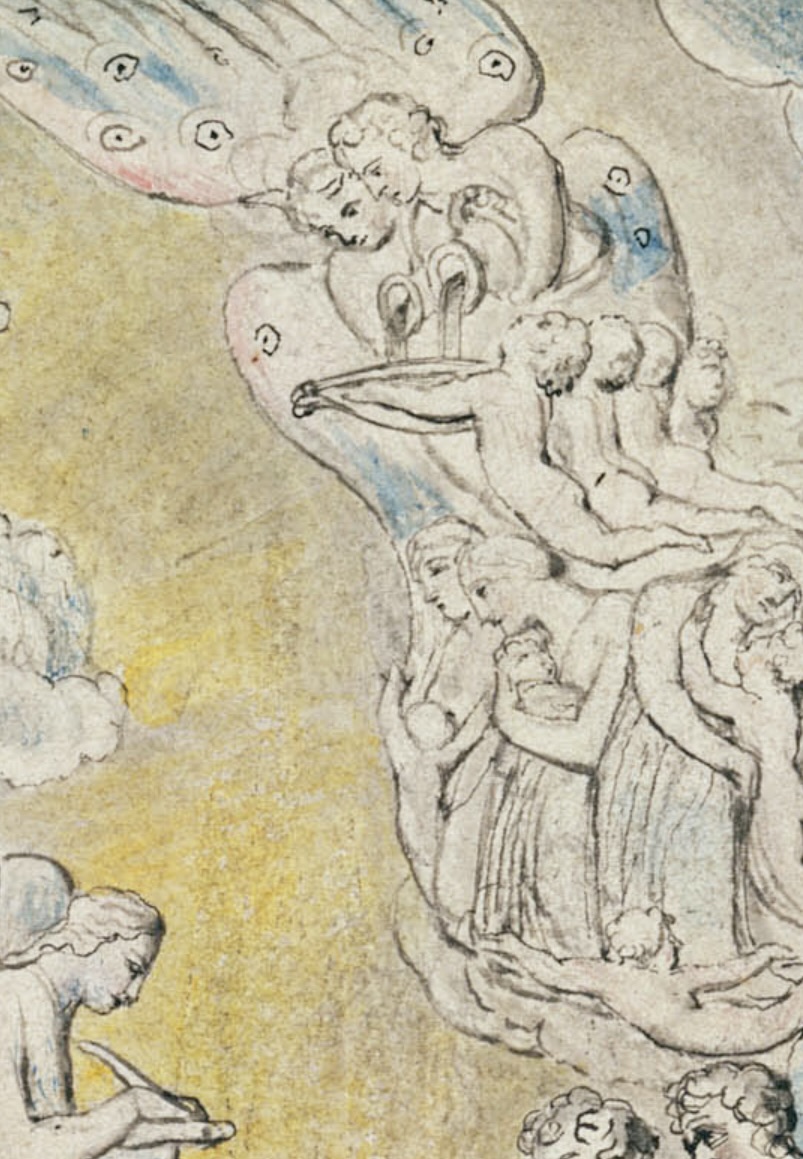
Nurturing, music, love, creation, flow .. a constant unfolding and enfolding of being itself.
Particularly striking in all of Blake’s depictions of the Last Judgment is the presence of children (signifying the potential for humanity, creativity, innocence, and joy), ascending towards the heaven state, and often seen in and through relationships of care (often held or accompanied by mothers, inspiring them onwards), signifying that it is only through relationship that we enter “heaven”.
The Woman with six infants or children also represents, Blake explained to Ozias Humphry, “the Church Universal, represented by a Woman Surrounded by Infants. There is such a State in Eternity: it is composed of the Innocent civilized Heathen & the Uncivilized Savage, who, having not the Law, do by Nature the things contain’d in the Law. This State appears like a Female crown’d with stars, driven into the Wilderness: she has the Moon under her feet.”
As such, the pregnant woman “clothed with the sun, and the moon under her feet, and upon her head a crown of twelve stars” has correlations with the same figure pursued and threatened by the astonishing Red Dragon in some of Blake’s most apocalyptic images of the moment of the confrontation between two incompatible and anomalous relational systems: Power, and Love – personal power or communal love.
The other dominant “signifier” of heaven in Blake’s images of this scene is creativity – often symbolised here, as always in Blake, through music in particular (inter-relational, affective, aural, joyous, flowing, patterned – a process or ongoing movement to dance and sing along with), and the presence of musical instruments (as in the final plate of Job). For Blake, the state called heaven, or Betweenness, is filled with music, song, joy, space, freedom.
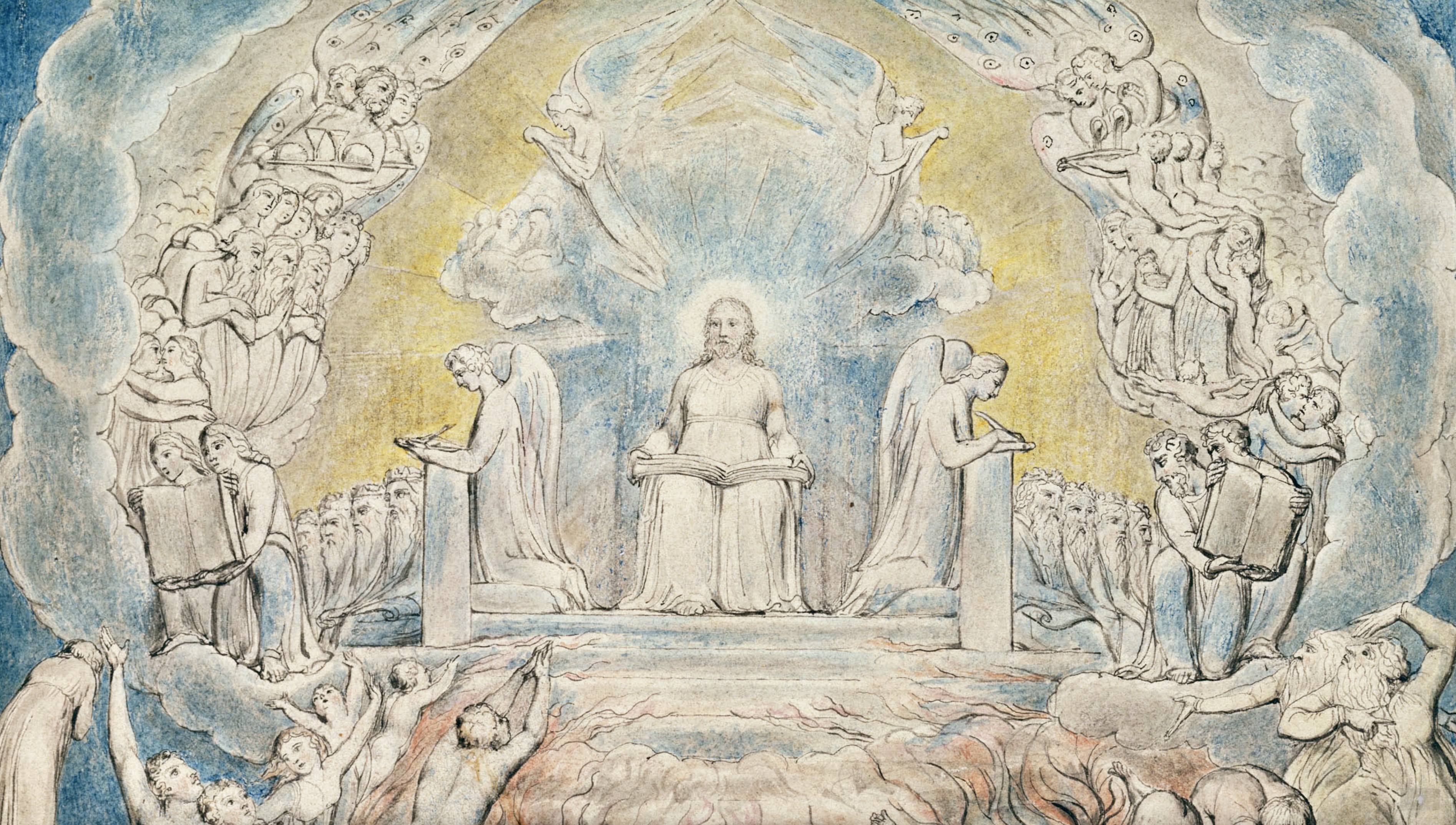
![]()
Rod Tweedy, PhD, is the author of The God of the Left Hemisphere: Blake, Bolte Taylor and the Myth of Creation (Routledge, 2013), a study of Blake’s work in the light of modern neuroscience; the editor of The Political Self: Understanding the Social Context for Mental Illness (Routledge, 2017), and the editor of The Divided Therapist: Hemispheric Difference and Contemporary Psychotherapy (Routledge, 2021). He is also an active supporter of Veterans for Peace UK and and the user-led mental health organisation, Mental Fight Club.
![]()


![]()